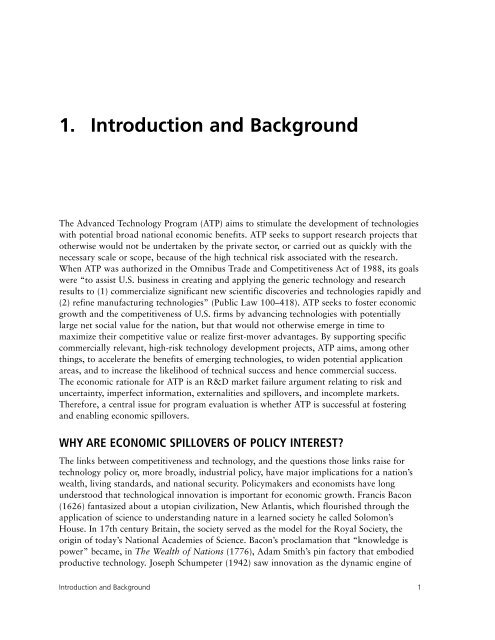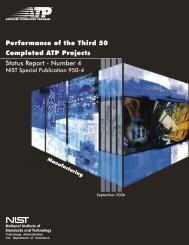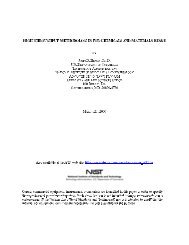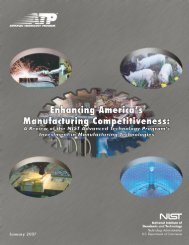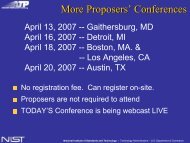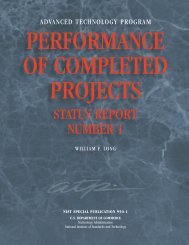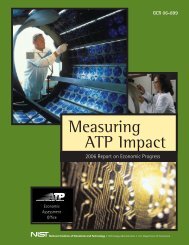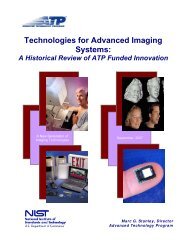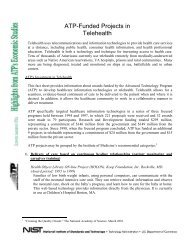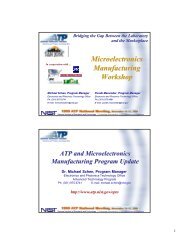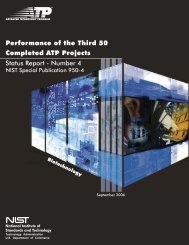Direct and Spillover Effects of ATP-Funded Photonics Technologies
Direct and Spillover Effects of ATP-Funded Photonics Technologies
Direct and Spillover Effects of ATP-Funded Photonics Technologies
- No tags were found...
Create successful ePaper yourself
Turn your PDF publications into a flip-book with our unique Google optimized e-Paper software.
1. Introduction <strong>and</strong> BackgroundThe Advanced Technology Program (<strong>ATP</strong>) aims to stimulate the development <strong>of</strong> technologieswith potential broad national economic benefits. <strong>ATP</strong> seeks to support research projects thatotherwise would not be undertaken by the private sector, or carried out as quickly with thenecessary scale or scope, because <strong>of</strong> the high technical risk associated with the research.When <strong>ATP</strong> was authorized in the Omnibus Trade <strong>and</strong> Competitiveness Act <strong>of</strong> 1988, its goalswere “to assist U.S. business in creating <strong>and</strong> applying the generic technology <strong>and</strong> researchresults to (1) commercialize significant new scientific discoveries <strong>and</strong> technologies rapidly <strong>and</strong>(2) refine manufacturing technologies” (Public Law 100–418). <strong>ATP</strong> seeks to foster economicgrowth <strong>and</strong> the competitiveness <strong>of</strong> U.S. firms by advancing technologies with potentiallylarge net social value for the nation, but that would not otherwise emerge in time tomaximize their competitive value or realize first-mover advantages. By supporting specificcommercially relevant, high-risk technology development projects, <strong>ATP</strong> aims, among otherthings, to accelerate the benefits <strong>of</strong> emerging technologies, to widen potential applicationareas, <strong>and</strong> to increase the likelihood <strong>of</strong> technical success <strong>and</strong> hence commercial success.The economic rationale for <strong>ATP</strong> is an R&D market failure argument relating to risk <strong>and</strong>uncertainty, imperfect information, externalities <strong>and</strong> spillovers, <strong>and</strong> incomplete markets.Therefore, a central issue for program evaluation is whether <strong>ATP</strong> is successful at fostering<strong>and</strong> enabling economic spillovers.WHY ARE ECONOMIC SPILLOVERS OF POLICY INTEREST?The links between competitiveness <strong>and</strong> technology, <strong>and</strong> the questions those links raise fortechnology policy or, more broadly, industrial policy, have major implications for a nation’swealth, living st<strong>and</strong>ards, <strong>and</strong> national security. Policymakers <strong>and</strong> economists have longunderstood that technological innovation is important for economic growth. Francis Bacon(1626) fantasized about a utopian civilization, New Atlantis, which flourished through theapplication <strong>of</strong> science to underst<strong>and</strong>ing nature in a learned society he called Solomon’sHouse. In 17th century Britain, the society served as the model for the Royal Society, theorigin <strong>of</strong> today’s National Academies <strong>of</strong> Science. Bacon’s proclamation that “knowledge ispower” became, in The Wealth <strong>of</strong> Nations (1776), Adam Smith’s pin factory that embodiedproductive technology. Joseph Schumpeter (1942) saw innovation as the dynamic engine <strong>of</strong>Introduction <strong>and</strong> Background 1


